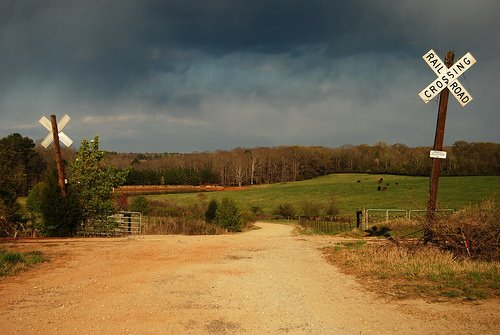September 23, 2012
Caesar's Head, SC
Each year, thousands of raptors migrate from the Northern U.S. to warmer climates. The Appalachian and Atlantic flyways are the two major routes used in the East. Caesar's Head is an excellent viewing point because it is high enough (3,266 feet) to get a good glimpse - with binoculars that is - of the birds that migrate at altitudes of up to 3,000-10,000 feet. It is also located atop a 2000 ft drop which creates an air updraft which the birds use for soaring ("slope soaring"). In addition to the slope updrafts, thermal currents form when the cool morning air mixes with the warm air as the day heats up. These thermals also allow the birds to soar to great altitudes from which they can glide for a long time without flapping a wing, conserving energy on their long trip to South America.
So every fall, bird enthusiasts and park rangers come here on a daily basis and count the birds that migrate through. Hawks sometimes form kettles, and as many as 500 birds have been observed in one kettle. With such numbers, observers count in 5s and 10s; an important rule is to count silently, then compare the totals and come up with a number most observers agree on. Visitors do their best to confuse everyone by forgetting this rule and counting out loud which always results in a collective "sssssshhhhh". In order to ensure that no resident birds are included in the migration counts, counting does not start when the hawks arrive but rather when they glide out of the area.
Observation hours are typically from 11 a.m. (as the day warms up) until 5 p.m. (after which the raptors start to settle down for dinner and the night).
 I have gotten pretty good at picking the peak day by following the counts in North Carolina and Virginia - when the numbers go up there, one can assume that those birds will reach South Carolina two days later. Today, the count when I left at around 2 p.m. was "only" 500 Broad-Winged Hawks, but the final count for the day was 2,603 Broad-Winged Hawks, 4 Osprey, 1 Bald Eagle, and 1 American Kestrel.
I have gotten pretty good at picking the peak day by following the counts in North Carolina and Virginia - when the numbers go up there, one can assume that those birds will reach South Carolina two days later. Today, the count when I left at around 2 p.m. was "only" 500 Broad-Winged Hawks, but the final count for the day was 2,603 Broad-Winged Hawks, 4 Osprey, 1 Bald Eagle, and 1 American Kestrel.
I also saw 3 Monarch butterflies flutter by. They migrate, too, which I find even more fascinating. The seem so fragile floating through the air 3,000 feet up, with nothing to rest on. The migrate all the way to Mexico.
 I have gotten pretty good at picking the peak day by following the counts in North Carolina and Virginia - when the numbers go up there, one can assume that those birds will reach South Carolina two days later. Today, the count when I left at around 2 p.m. was "only" 500 Broad-Winged Hawks, but the final count for the day was 2,603 Broad-Winged Hawks, 4 Osprey, 1 Bald Eagle, and 1 American Kestrel.
I have gotten pretty good at picking the peak day by following the counts in North Carolina and Virginia - when the numbers go up there, one can assume that those birds will reach South Carolina two days later. Today, the count when I left at around 2 p.m. was "only" 500 Broad-Winged Hawks, but the final count for the day was 2,603 Broad-Winged Hawks, 4 Osprey, 1 Bald Eagle, and 1 American Kestrel.I also saw 3 Monarch butterflies flutter by. They migrate, too, which I find even more fascinating. The seem so fragile floating through the air 3,000 feet up, with nothing to rest on. The migrate all the way to Mexico.
Tessa waiting for the hawks.














No comments:
Post a Comment